高中状语从句讲解(经典打印版)
(完整版)状语从句的讲解最全的状语从句讲解

状语从句的讲解就是用一句话作状语分为:时间,地点,方式,原因,结果,条件,让步,目的,比较一、时间状语从句第一次见到你一见到你我就喜欢上了你直到见到你五岁时见到你When, as, while, before, after, since, till/until, as soon as no sooner…than…scarcely…when…hardly…when… the minute the second the instant the moment by the time 截止 immediately instantly directlyeach time every time next time the first time on doing sthwhenwhile 当…时as1。
when 1)当…时/ 延续性动词短暂性动词都可用2)这时/3)届时、到时I was watching TV when my cellphone suddenly rang这时When I was five years old I could speak five languagesThe wet weather will continue tommorow when a cold front is expected to arrive届时到时注意:时间状语从句中动作发生有前后时先发生的用过去完成时When my mother came back I had already gone to bed.2。
while 1)从句动词延续性2)同时发生3)对比的意味“然而”4)趁着He taught himself while he worked in a bank 延续性动词当他在银行上班时While we were working they were having a rest.对比While they were having a discussion , they got very confused。
完整版)高中英语状语从句讲解及练习

完整版)高中英语状语从句讲解及练习状语从句是指在句中作状语的从句,可以分为时间、条件、让步、原因、目的、结果、比较、地点、方式状语从句。
时间状语从句的连词有when、as、while、until、not…until、before、after、since、the minute、the moment、each、every、next、the first time等。
时间状语从句一般使用一般现在时或一般过去时。
当使用when、as、while这三个连词引导时间状语从句时,它们都表示“当…的时候”,但侧重点有所不同。
例如,当使用when引导时间状语从句时,从句的主语与主句主语相同,如果谓语动词是be动词,则从句主语和be可以省略。
而as则不仅表示“当…的时候”,还可以表示“一面…一面”或“随着”。
而while则强调主句的动作和从句的动作同时发生,从句一般用进行时,从句动词必须是延续性动词。
当使用until、not…until时,它们表示“直到…才”。
在肯定句中,主句常用延续性动词;在否定句中,主句常用短暂性动词。
需要注意的是,当not until…位于句首时,主句需要倒装。
例如,“Not until you had explained how did I manage to do it.”It was dark when he finally returned。
XXX the machine type upon seeing it。
As soon as I arrived home。
it began to rain。
Hardly had I arrived home when it began to rain。
XXX: real XXX: if。
even if/though。
unless/if。
not。
as long as/so long as。
as far as/so far as。
provided/providing(that)。
(完整版)高中英语状语从句讲解和练习(含答案).docx

状从句解和状修、形容、副或整个句子。
通常由副、介短、不定式、分和从句等担当。
例如:1. Naturally , our grandparents were pleased to get our phone call . (副 )2.We worked hard , from sunrise to sunset . (介状短 )3.To help my disabled aunt , I spend an hour working in her house every day . (不定式 )4.Seen from a distance , the farmhouse looked deserted . (去分 )5.I know how to light a camp fire because I had done it before .(原因状从句)状的位置比灵活,可以位于句首、句末或句中。
enough用作状修形容和副必后置。
状从句主要用来修主句或主句的。
一般可分九大,分表示、地点、原因、目的、果、条件、步、比和方式。
尽管种多,但由于状从句与构和用法相似,所以理解和掌握它并不。
状从句的关是要掌握引不同状从句的常用接和特殊的接即考点。
分列如下:1.状从句常用引: when, as, while, as soon as, while, before, after, since , till,until特殊引: the minute, the moment, the second, every time, the day,the instant, immediately , direc tly, no sooner ⋯ than, hardly ⋯ when, scarcely ⋯ whenI didn ’realizet how special my mother was until I became an adult.While John was watching TV, his wife was cooking.The children ran away from the orchard(果园 ) the moment they saw the guard. Nosooner had I arrived home than it began to rain.Every time I listen to your advice, I get into trouble.2.地点状从句常用引: where特殊引: wherever, anywhere, everywhereGenerally, air will be heavily polluted where there are factories.Wherever you go, you should work hard.3.原因状从句常用引: because, since, as, since特殊引: seeing that, now that, in that, considering that, given that, considering that, Myfriends dislike me because I ’ mhandsome and successful.Now that everybody has come, let ’begins our conference.The higher income tax is harmful in that it may discourage people from trying to earn more. Considering that he is no more than 12 years old, his height of 1.80 m is quite remarkable.4.目的状从句常用引: so that, in order that特殊引: lest, in case, for fear that,in the hope that, for the purpose that, to the end that The boss asked the secretary to hurry up with the letters so that he could sign them.The teacher raised his voice on purpose that the students in the back could hear more clearly.5.果状从句常用引: so ⋯ that, so⋯ that, such ⋯ that,特殊引: such that, to the degree that, to the extent that, to such a degree that, He gotup so early that he caught the first bus.It ’such a good chance that we must not miss it.To such an degree was he excited that he couldn ’sleept last night.6.条件状从句常用引: if, unless,特殊引: as/so long as, only if,providing/provided that, suppose that, in case that, on condition thatWe’ ll start our project if the president agrees.You will certainly succeed so long as you keep on trying.Provided that there is no opposition, we shall hold the meeting here.7.步状从句常用引: though, although, even if, even though特殊引:as(用在步状从句中必要倒装),while ( 一般用在句首),no matter⋯,in spite of the fact that, while, whatever, whoever, wherever, whenever, however, whicheverMuch as I respect him, I can’agreet to his proposal.尽管我很尊敬他,我却不同意他的建。
高中状语从句讲解分享资料.pptx

结果
动作
方式
目的 原因
3
状语? 某个状态的程度
好 good
相当好 quite good
非常好 very good
4
可以作状语的有?
句子 短语 词
5
你必须把车停在这里。 You must park your car here. 你必须把车停在角落里。 You must park your car at the corner. 你必须把车停在人很少的地方。 You must park your car where there are few people.
44
结果状语从句: 主语 + 谓语 + so + adj./adv. + a/an+n.+that... 主语 +谓语 + such +(a/an) +adj. + n.+ that... “如此…以致于…”
45
He is __s_o___ poor ___t_h_a_t___ he can't buy a bike for his son.
(1)主句是肯定句时:主句是 肯定句时,从句也为肯定式 till/ until “直到......为止”
I will wait here till/ until you come back.
20
7.till; until ; not...until (2)主句是否定句时 not...until “直到......才......” I didn’t go to bed until my father came back.
28
3. __A_s__h_e_d_i_d_n_'_t _u_n_d_e_r_s_ta_n__d______ __E_n_g_l_i_sh__ (由于他不懂英语), he came back to China soon.
高中英语--状语从句专题讲解(详细)

注:
“no sooner…than…”,“hardly…when…”引导时间状语从句时,主句用过去完成时,从句用一般过去时。此外,当把no sooner, hardly/scarcely提到句首时,主句用部分倒装。
as意为“随着,一边…,一边…”,常有以下用法:
a)用于表示两个动作同时或者几乎同时发生。
b)表示两个发展变化中的情况。
c)表示在某事发生的过程中另外一件事发生。
d)表示随着短暂动作的发生,另一动作立刻发生。
before和after引导的时间状语从句
before意为“在…之前”,表示主句动作发生在从句动作之前。
=I hardly told him the news when he stopped listening.
地点状语从句
地点状语从句的引导词有when和wherever。
where, wherever指具体地点时,从句可用于主句之前或之后;
where, wherever表示抽象概念的含义时,从句需放在主句前。
When hehad finishedhis homework, hetooka short rest.(先发生+后发生)
When Igotto the airport, the guesthad left.(后发生+先发生)
注:
when还可表示原因,意为“既然”,引导原因状语从句;也可以用作并列连词,意为“就在那时”,常构成如下结构:
A number of high buildings have arisen where there was nothing a year ago but ruins.(where表示具体地点)
高中英语状语从句详细讲解及例句
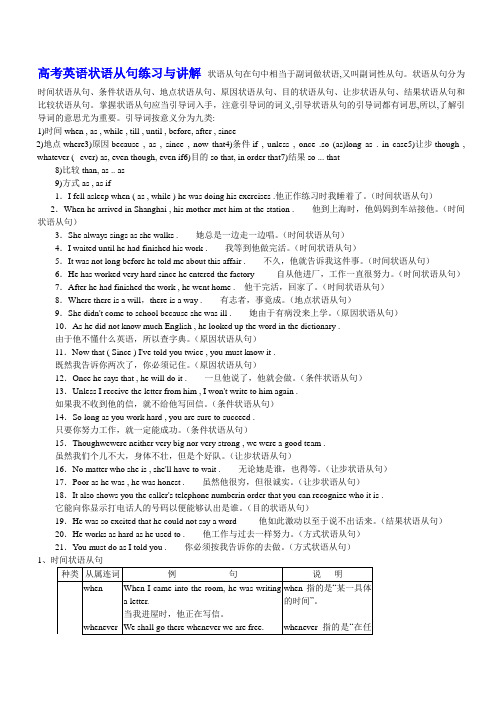
高考英语状语从句练习与讲解状语从句在句中相当于副词做状语,又叫副词性从句。
状语从句分为时间状语从句、条件状语从句、地点状语从句、原因状语从句、目的状语从句、让步状语从句、结果状语从句和比较状语从句。
掌握状语从句应当引导词入手,注意引导词的词义,引导状语从句的引导词都有词思,所以,了解引导词的意思尤为重要。
引导词按意义分为九类:1)时间when , as , while , till , until , before, after , since2)地点where3)原因because , as , since , now that4)条件if , unless , once .so (as)long as . in case5)让步though , whatever (--ever) as, even though, even if6)目的so that, in order that7)结果so ... that8)比较than, as .. as9)方式as , as if1.I fell asleep when ( as , while ) he was doing his exercises .他正作练习时我睡着了。
(时间状语从句)2.When he arrived in Shanghai , his mother met him at the station .他到上海时,他妈妈到车站接他。
(时间状语从句)3.She always sings as she walks .她总是一边走一边唱。
(时间状语从句)4.I waited until he had finished his work .我等到他做完活。
(时间状语从句)5.It was not long before he told me about this affair .不久,他就告诉我这件事。
(时间状语从句)6.He has worked very hard since he entered the factory 自从他进厂,工作一直很努力。
状语从句讲解经典
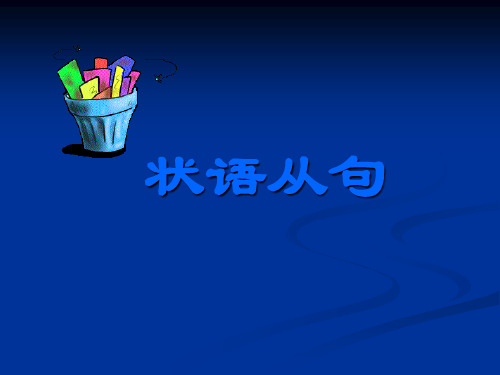
意思为既然或考虑到 (原因状语从句) It was foolish of you to take a taxi when you could easily walk there. How can they learn anything when they spend all their spare time watching television? Why do you want a new job when you have got such a good one? There is no point (in) owning a car when we have so good a public transport system. Why use metal when you can use plastic? How can he get the promotion when his boss dislikes him?
I will tell her about it when I see her. I was about to fall asleep when my sister came in. I will go home when he comes back.
I recognized the thief when/ as I passed him. When he finished his lecture, people stood up and applauded. I was walking on the street when I came across an old friend. We were about to set off when it began to rain. He had just finished the work when the doorbell rang. We were on the point of driving away when the policeman signed us to stop.
高中英语状语从句精华知识点讲解

状语从句一、从句讲解状语从句是一种副词性从句,通常由一个从属连词或一个起连词作用的词组引导。
(一)原因状语从句引导原因状语从句的常见连词或短语:as, because, since, now that, considering that, seeing that(鉴于……)。
注意以下几点:1. because, since, as, for, now thatbecause语气最强,用于回答why的提问,可与强调词only, just 以及否定词not 连用。
但不可以与so 连用。
since 引导的从句语气次于because引导的从句,常表示稍加分析后而推断出的原因,或指人们已知的事实,比as正式一些,常置于句首。
as 语气最弱,其原因只是对结果的附带说明,一般放在句首。
for虽然解释为“因为”但只是一个并列连词,它也常引导句子表示原因,但不是原因状语从句,它是一个并列句。
for所提供的理由是一种补充性的说明,表示推测的理由。
now that意为“既然,由于”。
表示由于人们已知的事实或正在发生的事而产生某个结果。
He failed because he was careless.他因粗心而失败了。
Since everyone has come, let’s begin our meeting.既然大家都来了,我们开会吧。
As all the seats were full, he stood there.所有的座位都满了,他只好站那儿。
It might have rained last night for the ground is wet.昨晚可能下雨了,因为地面是湿的。
Now that the kids have left home we have a lot of extra space.由于孩子们离开了家,所以我们有了额外的空间。
(二)地点状语从句地点状语从句常由下列连词引导:where, wherever等。
(完整版)高中英语状语从句讲解及练习.doc

状从句状从句在句中作状,可分:、条件、步、原因、目的、果、比、地点、方式状从句。
一、状从句引状从句的有:when, as,while, until, not ⋯ until, before, after, since, the minute, the moment, each( every, next,the first) time 等。
状从句中一般用一般在或一般去。
1. When , while, as 都可解“当 ```的候”但重点有所不同。
1)WhenEg: When I arrived home , I had a littlerest.注意点:when 从句的主与主句主相同,是be ,从句主和 be 可以省略。
Eg: When (she was) walking along the street, she met her class teacher.2)AsAs 除了表示“当 ``` 的候”,可表示“一面```一面”,“随着”Eg: He sang as he danced一.(面 ```一面 ) You will grow wiser as you grow older.(随着 )3)W hile 表示“当 ```的候” 主句的作和从句的作同生,从句一般用行,从句必是延性。
Eg: While we were working, they were having a rest.While (they were) having a discussion, they got very confused.注意点:while 有比的含,解“然而”。
eg: I prefer black tee, while he likes coffee.2. until, not ⋯ until 表示“直到 ``` 才” , 在肯定句中主句常用延性;在否定句中主句常用短性。
肯定句: I waited until midnight.否定句: I did not leave until midnight.注意点:1)not until在⋯句首,主句用倒装eg: Not until you had explained how did I manage to do it.2) It is not until⋯引that的⋯ 句It was not until it was dark that he came back.3.the minute, the moment, each time都可表示“一 ```就```”eg: The worker recognized the type ofthe machine the moment he saw it.注意点:the minute, the moment, each ( every, next, the first) time 作不和 when 用。
(完整word版)高中状语从句语法及例句
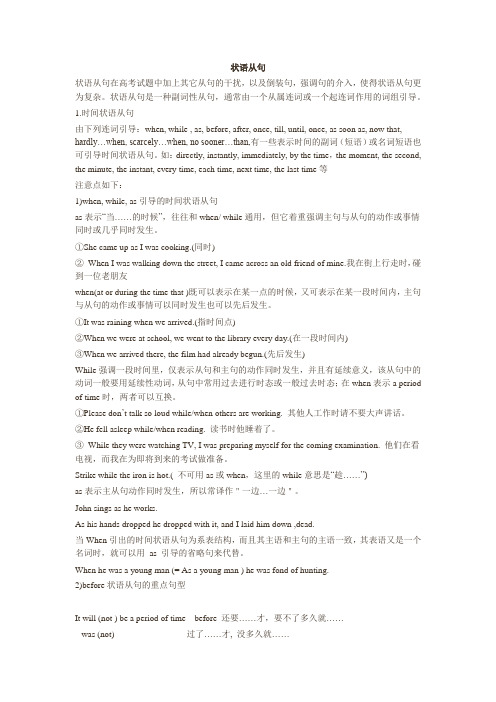
状语从句状语从句在高考试题中加上其它从句的干扰,以及倒装句,强调句的介入,使得状语从句更为复杂。
状语从句是一种副词性从句,通常由一个从属连词或一个起连词作用的词组引导。
1.时间状语从句由下列连词引导:when, while , as, before, after, once, till, until, once, as soon as, now that, hardly…when, scarcely…when, no sooner…than,有一些表示时间的副词(短语)或名词短语也可引导时间状语从句。
如:directly, instantly, immediately, by the time,the moment, the second, the minute, the instant, every time, each time, next time, the last time等注意点如下:1)when, while, as引导的时间状语从句as表示“当……的时候”,往往和when/ while通用,但它着重强调主句与从句的动作或事情同时或几乎同时发生。
①She came up as I was cooking.(同时)②When I was walking down the street, I came across an old friend of mine.我在街上行走时,碰到一位老朋友when(at or during the time that )既可以表示在某一点的时候,又可表示在某一段时间内,主句与从句的动作或事情可以同时发生也可以先后发生。
①It was raining when we arrived.(指时间点)②When we were at school, we went to the library every day.(在一段时间内)③When we arrived there, the film had already begun.(先后发生)While强调一段时间里,仅表示从句和主句的动作同时发生,并且有延续意义,该从句中的动词一般要用延续性动词,从句中常用过去进行时态或一般过去时态;在when表示a period of time时,两者可以互换。
(完整版)高中英语语法-状语从句归纳总结.doc

1状语从句状语从句一.分:种接when/whenever/while/as/before/after/instantly/until/till/by the time /as soon as/hardly⋯when/no sooner⋯than/the moment/theminute/immediately有一些表示的名短也可用来引状从句: the minute,the moment, every time, the first time例: The moment he reached the country, he started his 状search. 他一到达个国家,就开始他的探工作。
有一些表示的副也可用来引状从句:directly例: Directly the master came in, everyone was quiet.校一来,大家就安静下来地点where//wherever状原因Because/as/since/now that/for状注意区:as和 when、while :as, when 引短性作的。
当从句的作生于主句作之前,只能用 when 引个从句,不可用 as 或 while 。
从句表示 " 随推移 " 能用as,不用 when 或 while 。
till/until和not⋯till/until:until 可用于句首,而till 通常不用于句首。
where,表示某一个;wherever,表示任何一个。
because和 since、for、 as、now that:because最,用来明人所不知的原因,回答why 提出的。
当原因是而易的或已人所知,就用as 或since。
由 because 引的从句如果放在句末,且前面有逗号,可以用 for 来代替。
但如果不是明直接原因,而是多种情况加以推断,就只能用 for。
now that 都表示“既然” now that 一定要是在生的, since 可以是在,也可以是去和在。
(完整版)状语从句超详细讲解
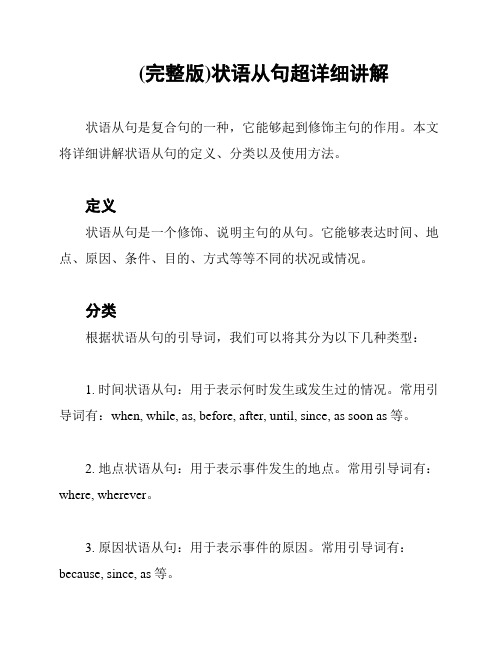
(完整版)状语从句超详细讲解状语从句是复合句的一种,它能够起到修饰主句的作用。
本文将详细讲解状语从句的定义、分类以及使用方法。
定义状语从句是一个修饰、说明主句的从句。
它能够表达时间、地点、原因、条件、目的、方式等等不同的状况或情况。
分类根据状语从句的引导词,我们可以将其分为以下几种类型:1. 时间状语从句:用于表示何时发生或发生过的情况。
常用引导词有:when, while, as, before, after, until, since, as soon as等。
2. 地点状语从句:用于表示事件发生的地点。
常用引导词有:where, wherever。
3. 原因状语从句:用于表示事件的原因。
常用引导词有:because, since, as等。
4. 条件状语从句:用于表示某种条件下发生的情况。
常用引导词有:if, unless, provided that, as long as等。
5. 目的状语从句:用于表示主句中的动作或状态的目的。
常用引导词有:so that, in order that。
6. 方式状语从句:用于表示主句中的动作或状态发生的方式。
常用引导词有:as, as if, as though。
使用方法在使用状语从句时,需要注意以下几点:1. 引导词的选择要准确。
不同类型的状语从句需要选择相应的引导词,以确保表达的准确性。
2. 状语从句的位置可以灵活调整。
可以将状语从句放在主句之前、之后或中间,但要注意语序的调整,以保证句子的通顺。
3. 使用适当的标点符号。
根据句子结构和语义需要,可以在状语从句和主句之间使用逗号、连词等标点符号。
4. 注意主从句的时态和语态一致性。
主句和状语从句之间的动作发生时间要一致,并保持相同的语态。
总结状语从句是一种修饰主句的从句,能够表达时间、地点、原因、条件、目的、方式等不同状况。
根据引导词的不同,状语从句可以分为时间状语从句、地点状语从句、原因状语从句、条件状语从句、目的状语从句和方式状语从句。
(完整word)高中英语状语从句讲解及练习.doc

状从句在复合句中作状,位置灵活。
状从句可分状从句,目的状从句,条件状从句,步状从句,地点状从句,原因状从句,方式状从句,果状从句。
(一)状从句1. when, as, whilea. when 表,从句既可以用延性,又可以用瞬。
Eg: When I get there I will call you.如果 when 引的状的主与主句的主相同,而从句的又是be ,那么从句中的主与be 可省。
Eg: When ( you are) in trouble, you can ask her for help.如果 when 引的状的主与主句的主相同,往往可以用“when+分”的形式代替状从。
Eg: When I came into the room(When coming into the room), I found the light was off.b.while 表,从句需用延性,或者主句的作生在从句的作行程中。
主句的通常是非延性。
Eg: He came in while I was reading a book.I met her while I was in school.c. as 表,与 when 相似,但重主从句作同在点或同段行。
同可表示主句的作随着从句的作的化而化。
Eg: He jumps as he sings.As the wind rose, the noise increased.2.before(在⋯⋯之前 )与 after(在⋯⋯之后)Eg:See me before you leave.I saw them after I arrived.3.till 与 until肯定形式表示的意思是" 做某事直至某"。
否定形式表达的意思是"直至某才做某事" 。
Eg: Wait till/untill I call you.等着直到我叫你。
She didn't arrive till/until 6 o'clock..她直到 6 点才到但是置于句首只可用untill.Until you told me, I had heard nothing of what happened.直到你告我以前,出了什么事我一点也不知道。
状语从句(思维导图)可打印(1页)

状语从句(思维导图)可打印(1页)1. 时间状语从句:时间状语从句用于表达句子中的时间关系,常用的引导词有:when, while, as, before, after, since, until等。
例如:When I wake up, I will have breakfast.2. 地点状语从句:地点状语从句用于表达句子中的地点关系,常用的引导词有:where, wherever等。
例如:Wherever you go, I will follow you.3. 原因状语从句:原因状语从句用于表达句子中的原因关系,常用的引导词有:because, since, as等。
例如:Because it was raining, we stayed at home.4. 条件状语从句:条件状语从句用于表达句子中的条件关系,常用的引导词有:if, unless, in case等。
例如:If you study hard, you will pass the exam.5. 结果状语从句:结果状语从句用于表达句子中的结果关系,常用的引导词有:so, that等。
例如:I was so tired that I couldn't move.状语从句(思维导图)可打印(1页)1. 目的状语从句:目的状语从句用于表达句子中的目的关系,常用的引导词有:in order to, so that, that等。
例如:I went to the library in order to study for the exam.2. 让步状语从句:让步状语从句用于表达句子中的让步关系,常用的引导词有:although, though, even though, despite等。
例如:Although it was raining, we went for a walk.3. 比较状语从句:比较状语从句用于表达句子中的比较关系,常用的引导词有:than, asas, morethan等。
高中英语状语从句用法详解文档
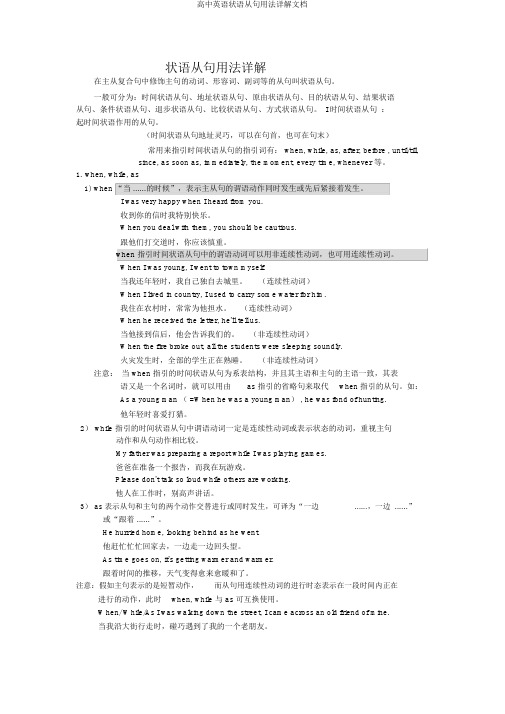
状语从句用法详解在主从复合句中修饰主句的动词、形容词、副词等的从句叫状语从句。
一般可分为:时间状语从句、地址状语从句、原由状语从句、目的状语从句、结果状语从句、条件状语从句、退步状语从句、比较状语从句、方式状语从句。
I 时间状语从句:起时间状语作用的从句。
(时间状语从句地址灵巧,可以在句首,也可在句末)常用来指引时间状语从句的指引词有: when, while, as, after, before , until/till, since, as soon as, immediately, the moment, every time, whenever 等。
1.when, while, as1)when “当 ......的时候”,表示主从句的谓语动作同时发生或先后紧接着发生。
I was very happy when I heard from you.收到你的信时我特别快乐。
When you deal with them, you should be cautious.跟他们打交道时,你应该慎重。
when 指引时间状语从句中的谓语动词可以用非连续性动词,也可用连续性动词。
When I was young, I went to town myself.当我还年轻时,我自己独自去城里。
(连续性动词)When I lived in country, I used to carry some water for him.我住在农村时,常常为他担水。
(连续性动词)When he received the letter, he'll tell us.当他接到信后,他会告诉我们的。
(非连续性动词)When the fire broke out, all the students were sleeping soundly.火灾发生时,全部的学生正在熟睡。
(非连续性动词)注意:当 when 指引的时间状语从句为系表结构,并且其主语和主句的主语一致,其表语又是一个名词时,就可以用由as 指引的省略句来取代when 指引的从句。
- 1、下载文档前请自行甄别文档内容的完整性,平台不提供额外的编辑、内容补充、找答案等附加服务。
- 2、"仅部分预览"的文档,不可在线预览部分如存在完整性等问题,可反馈申请退款(可完整预览的文档不适用该条件!)。
- 3、如文档侵犯您的权益,请联系客服反馈,我们会尽快为您处理(人工客服工作时间:9:00-18:30)。
状语从句1. 时间状语从句(1) when引导的时间状语从句①when引导的时间状语从句,其动词既可以是延续性动作的动词,也可以是瞬间性动作的动词,可以表示主句的动作和从句的动作同时发生,或从句的动作发生在主句的动作之前。
when you apply for a job, you must present your credentials.当你申请工作时,你必须递交你的有关证件。
(同时)when the students heard the teacher’s footsteps, they a ll adopted talking.当学生们听到老师的脚步声时,他们都停止了讲话。
(从句动作发生在前)② when还可表示just then(正在那时)的意思,此时其所引导的从句只放在主句之后。
we were about to start when it began to rain. 我们正要动身,突然天下起雨来。
The game had hardly/scarcely/barely begun when it started raining. 比赛刚刚开始就下起雨来。
(2) as引导的时间状语从句as侧重表示主句和从句的动作并相发生,翻译成一边,一边。
We were having breakfast as she was combing her hair. 她梳头时我们在吃早饭。
(3) while引导的时间状语从句while或“在……期间”,所引导的从句的动作是延续性的,并表示和主句的动作同时发生。
When the teacher paraphrased the text in English, the students listened attentively and took notes. 当老师用英语解释课文时,学生们聚精会神地听并做着笔记。
I can learn while I work. 我可以边工作边学习。
(4) before引导的时间状语从句① before“在……之前”I’ll be back before you have left. 你离开之前我就会回来。
② before“……之后才”It may be many years before we meet again. 可能要过许多年我们才能再见了。
It was three days before I came back. 他三天后才回来。
(5) as soon as/once/directly/the instant等引导的时间状语从句as soon as 是最常见的表示“一……就”的从属连词,其他连词还有immediately,instantly,the instant (that),the minute(that) ,the moment(that)等,它们通常都可与as soon as换用。
As soon as we got home, the telephone rang. 我们一到家,电话就响了。
I recognized her immediately I saw her. 我一看见她就认出她来了。
Directly the teacher came in everyone was quiet. 老师一进来,大家就静了下来。
(6) hardly...when/no sooner...than引导的时间状语从句关联从属连词hardly/barely/scarcely...when和no sooner...than的意思是“刚……就”,它们所引导的从句中的谓语动词通常为过去完成时。
如:He had no sooner (no sooner had he)arrived home than he was asked to start on another journey. 他刚一到家,就又要他出另一次差。
No sooner had the words been spoken than he realized that he should have remained silent.这些话刚一出口,他就意识到自己应该保持沉默。
(7) since引导的时间状语从句在含有since引导的时间状语从句的复合句中,从句的谓语动词通常为一般过去时,主句的谓语动词通常为现在完成时、过去完成时和一般现在时:We’ve never met since we graduated from the college. 大学毕业后我们就再没见过面。
Great changes have taken place since you left. 你走了以后,这里发生了巨大变化。
(8) till/until引导的时间状语从句till和until同义,作“直到……时(为止)”解,till多口语话,until多用于句首。
如:Donald will remain in college until(till) he finishes his Ph.D course.唐纳德将留在学校直到完成他的博士学位课程。
I won’t go with you until(till) I finished my homework. 等我做完作业我才和你一起去。
2. 地点状语从句(1) where引导的地点状语从句,很简单,最基础的。
从属连词where“在(或到)……的地方”Where there is a will, there is a way. 有志者事竟成。
Put it where you found it. 把它放在原来的地方。
① where 在地点状语从句中,除指地点外,还可指处境等。
就看句子翻译了。
如:He said he was happy where he was. 他说他对自己的处境很满意。
It’s your fault that she is where she is. 她今天落到这个地步都怪你。
(2) wherever引导的地点状语从句wherever=no matter where,后者只能放句首。
从属连词wherever“在(或到)……的各个地方”:You can go wherever(anywhere) you like these days. 这些天你可以去你想去的地方。
Where (no matter where) they went, the experts were warmly welcomed.专家每到一处,都受到热烈的欢迎。
Sit down wherever you like. 你喜欢坐哪儿就坐哪儿wherever不可以换成no matter where3. 原因状语从句(1) because引导的原因状语从句通常用于回答why引出的疑问句,语气最强,该从句一般位于主句后面。
I didn’t go abrord with her because I couldn’t afford it. 我没有和她一起出国是因为费用太高。
Don’t scamp your work because you are pressed for time. 不要因为时间仓促而马马虎虎。
(2) as引导的原因状语从句as引导的原因状语从句多位于主句之前,通常可以和since换用。
如:As I didn’t know the way,I asked a policeman. 我不认识路,因而问警察。
As it is snowing, we shall not climb the mountain. 由于在下雪,我们不去爬山了。
(3) since引导的原因状语从句since引导的原因状语从句多位于主句之前,通常可以和as换用。
与as用法一样Since traveling by air is much faster,they decided to take a plane. 既然乘飞机旅行快得多,他们就决定坐飞机。
Since you won’t help me ,I’ll ask someone else. 你既然不帮我,那我就请别人帮忙。
(4) now(that)引导的原因状语从句now(that)“既然”,Now(that) you have passed your test you can drive on your own. 你既已考试合格,就可以独自开车了。
(5) seeing (that)引导的原因状语从句Seeing (t hat)“鉴于;由于”,通常用于非正式文体。
如:Seeing (that) the weather is bad,we’ll stay at home. 天气不好,我们还是呆在家里吧。
4. 目的状语从句(1) in order that引导的目的状语从句in order that“为了;以便”。
多用于正式文体,通常可以与so that换用。
如:You stopped at Hangzhou in order that they could go around West Lake.他们在杭州停了下来,以便游览西湖。
The expert spoke slowly in order that everyone should understand.专家讲得很慢,以便人人听得懂。
(2) so (that)引导的目的状语从句so that“为了;以便”。
so that通常可以与in order that换用,它所引导的目的状语从句总是放在主句之后,在非正式文体中,常省略that。
如:Speak clearly so that they may understand you. 你要讲得清楚,他们才听得懂。
She wanted tea ready at seven so she could be out by eight.她要七点钟备好茶点,这样她八点以前就可以出门了。
(3) in case/for fear (that)等引导的目的状语从句in case,for fear(that)这俩个从属连词都表示否定目的,意思是“以免”,“以防”。
in case它所引导的从句中的谓语动词可以是陈述语气形式,也可以是虚拟语气形式;for fear(that)引导的从句中的谓语带有may,might,should等情态动词Take your umbrella in case it rains. 带上你的伞,以防下雨。
He took an umbrella with him for fear that it might rain. 他带了一把伞,以防下雨。
1. 结果状语从句(1) so that引导的结果状语从句① so that引导的结果状语从句只能位于主句之后,so that”引导什么从句根据句意来判断Suddenly it began to rain heavily,so that it was almost impossible to carry on driving.突然下起了大雨,几乎无法继续开车。
